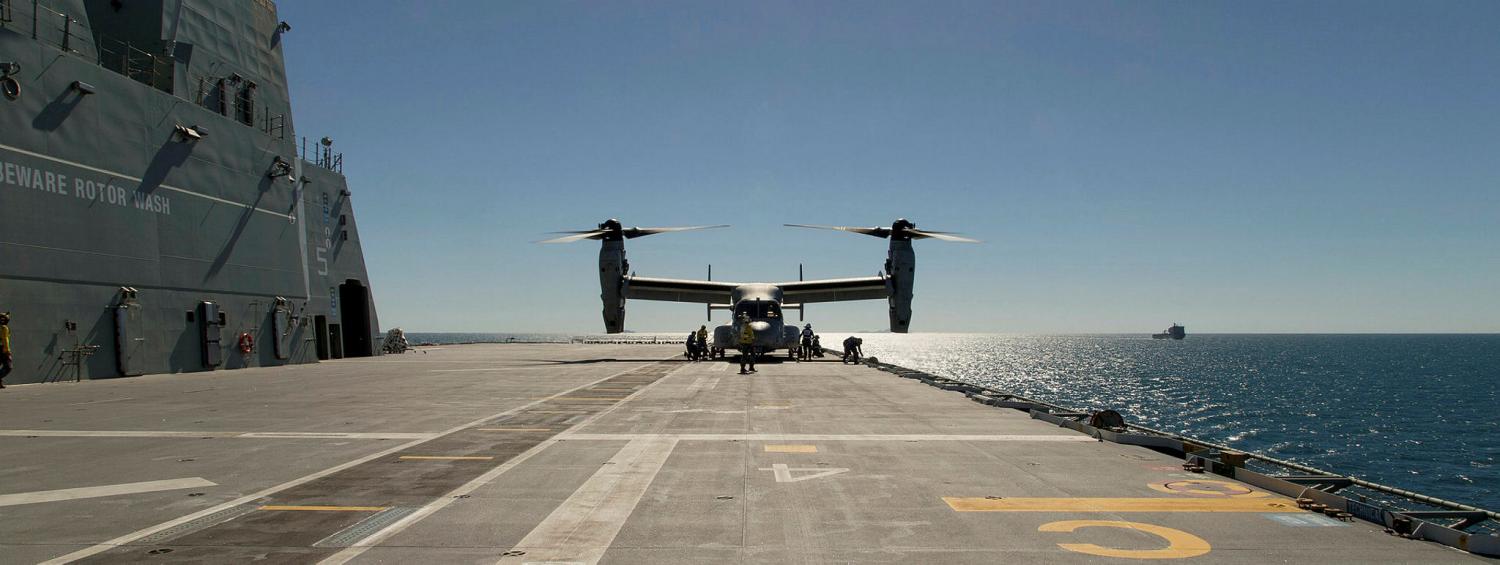It was an Australian Defence Force (ADF) public relation officer’s dream. ABC news footage, delivered directly into the living rooms of Australian families, showed Australian troops and Australian armoured vehicles streaming across the beach and onwards into the hinterland of Queensland. Australian landing craft, launched from the (now working) Australian Canberra class amphibious assault ship had transported the land forces to the beach. Meanwhile, Australian MRH90 helicopters flew in more soldiers to landing zones inland, demonstrating the ability for the amphibious force to arrive by sea or air. While Exercise Talisman Sabre was a coalition interoperability exercise, it was also an unapologetic display of the host nation’s capabilities.
Over the last weekend it became apparent that it is not only the Australian public who have been interested in the exercise. The China’s People’s Liberation Army – Navy (PLA-N) sent a 6000-ton, Type-815 Dongdiao Class ship, designed specifically for intelligence gathering, to sit in international waters in the vicinity of the exercise. As noted by my colleague Euan Graham this is the first time the PLA-N has so overtly collected off the Australian mainland during a major exercise. Yet Talisman Sabre 17 is the seventh iteration of this biennial exercise. So why has China decided to do so now?
As the largest amphibious landing Australia has executed since the Second World War, Talisman Sabre 17 was certainly an impressive display of Australia’s developing military capability. But behind the visually exciting display of helicopters and tanks, landing craft and fighter jets, lies a more significant fact: for the first time in more than 30 years Australia has a military strategy that is beginning to truly align ends, ways and means. This is unlikely to have gone unnoticed in Beijing.
Realisation of strategy
Ever since the Dibb report of 1986, Australian Defence White Papers have, to a greater or lesser extent, viewed security priorities through a ‘concentric circles’ approach. As such, the security of Australia’s maritime approaches through the archipelagic region to the north, as well as through the island chains of the South Pacific, has been a key defence objective. Yet, rarely has this strategic end-state been matched with the ways or means to achieve it. There are many reasons for this. Budgetary constraints, legacy equipment, the absence of an existential threat, and a lack of political will have all played a role in ensuring a mismatch between ends, ways and means.
Of course, that is not to say that Australia has been unable to operate in the region. Operations in East Timor in 1999 and the Solomon Islands in 2003 both contained amphibious elements. Yet these were both benign environments for the amphibious force and, at worst, uncertain environments on land. The ships that enabled those operations, HMAS Manoora, HMAS Kinimbla and HMAS Tobruk, were aging platforms that would have struggled to operate in contested environments. Their forced retirement prior to the Canberra class assault ships coming online left an even bigger gap in the ADF’s ability to conduct operations in the region.
Take as an example the last Exercise Talisman Sabre, held in 2015. Although still a significant exercise in its own right, the ADF’s contribution was far more modest than this year. The only Australian amphibious ship able to contribute was HMAS Choules which, while able to carry a large amount of equipment, can only carry a standard embarked force of approximately 350 troops, about a third of the capacity of the Canberra class ships.
While an important stepping stone in the development of Australia’s amphibious capability, the 2015 exercise demonstrated that Australia was still unable to unilaterally conduct amphibious operations in the South Pacific. In effect, the Australian Defence Force would have been severely challenged to carry out the second ‘strategic interest’ as directed in the 2013 Defence White Paper, namely the ‘security, stability and cohesion of our immediate neighbourhood, which we share with Papua New Guinese, Timor-Leste and South Pacific states’.
The 2013 Defence White Paper continued:
Australia seeks to ensure that our neighbourhood does not become a source of threat to Australia and that no major power with hostile intentions establishes bases in our immediate neighbourhood from which it could project force against us.
It is not surprising this strategic goal has such weight. The latest statistical analysis from the government, which covers the period 2014-2015, indicates that maritime imports and exports over that 12-month period totalled $424.9 billion. This was transported by merchant shipping using trade routes that traverse the archipelagic region to Australia’s north or through the South Pacific towards the United States. Maintaining an amphibious force capable of keeping these routes open if threatened by a hostile force is a key strategic end-state and critical to Australia’s national interest. Exercise Talisman Sabre 15 showed Australia still lacked the means to achieve this.
What a difference two years makes. This year’s exercise has shown that the ADF can now project a combined arms battlegroup over the shore and sustain it during mid-intensity warfighting. A significant role of any defence force is to act as a deterrent and to do so it must be capable against a range of high-end threats. The ADF has demonstrated that it is now able to conduct major amphibious operations throughout the region, either unilaterally or as part of a coalition with the United States or New Zealand. As such, for the first time in three decades, Australia now has the military capability to back up its stated defence strategy. It is little wonder the Chinese have taken notice.

